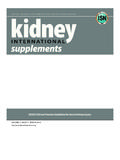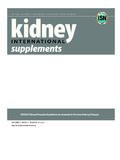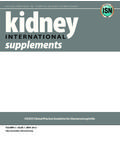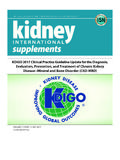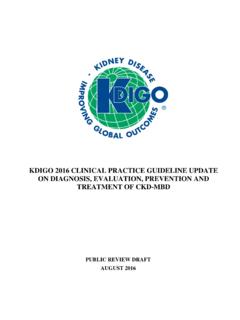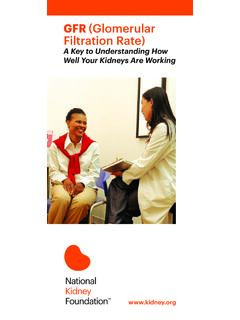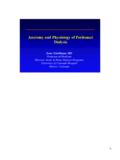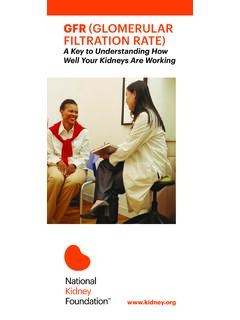Transcription of Drug dosing consideration in patients with acute and ...
1 Drug dosing consideration in patients with acute andchronic kidney disease a clinical update fromKidney Disease: Improving Global Outcomes (KDIGO)Gary R. Matzke1, George R. Aronoff2, Arthur J. Atkinson Jr3, William M. Bennett4, Brian S. Decker5,Kai-Uwe Eckardt6, Thomas Golper7, Darren W. Grabe8, Bertram Kasiske9, Frieder Keller10, Jan T. Kielstein11,Ravindra Mehta12, Bruce A. Mueller13, Deborah A. Pasko14, Franz Schaefer15, Domenic A. Sica16,Lesley A. Inker17, Jason G. Umans18and Patrick Murray191 Virginia Commonwealth University, School of Pharmacy, Richmond, Virginia, USA;2 University of Louisville, Louisville, Kentucky, USA;3 Northwestern University, Chicago, Illinois, USA;4 Legacy Transplant Services, Portland, Oregon, USA;5 Indiana University School ofMedicine, Indianapolis, Indiana, USA;6 University of Erlangen-Nuremberg, Erlangen, Germany;7 Vanderbilt Medical Center, Nashville,Tennessee, USA;8 Albany College of Pharmacy and Health Sciences, Albany, New York, USA;9 Hennepin County Medical Center,Minneapolis, Minnesota, USA;10 Nephrology, Ulm University, Ulm, Germany;11 Medical College of Hannover, Hannover, Germany;12 University of California San Diego, San Diego, California, USA;13 University of Michigan-School of Pharmacy, Ann Arbor, Michigan,USA;14 University of Michigan Health System, Ann Arbor, Michigan USA.
2 15 Heidelberg University Hospital, Heidelberg, Germany;16 Virginia Commonwealth University, School of Medicine, Richmond, Virginia, USA;17 Tufts Medical Center, Boston, Massachusetts, USA;18 Georgetown University Medical Center, Washington, DC, USA and19 University College, Dublin School of Medicine and Medical Science,Dublin, IrelandDrug dosage adjustment for patients with acute or chronickidney disease is an accepted standard of practice. Thechallenge is how to accurately estimate a patient s kidneyfunction in both acute and chronic kidney disease anddetermine the influence of renal replacement therapies ondrug disposition. Kidney Disease: Improving GlobalOutcomes (KDIGO) held a conference to investigate theseissues and propose recommendations for practitioners,researchers, and those involved in the drug development andregulatory arenas. The conference attendees discussed themajor challenges facing drug dosage adjustment for patientswith kidney disease.
3 In particular, although glomerularfiltration rate is the metric used to guide dose adjustment,kidney disease does affect nonrenal clearances, and this isnot adequately considered in most pharmacokinetic are also inadequate studies in patients receiving allforms of renal replacement therapy and in the pediatricpopulation. The conference generated 37 recommendationsfor clinical practice, 32 recommendations for future researchdirections, and 24 recommendations for regulatory agencies(US Food and Drug Administration and European MedicinesAgency) to enhance the quality of pharmacokinetic andpharmacodynamic information available to KDIGO Conference highlighted the gaps and focusedon crafting paths to the future that will stimulate researchand improve the global outcomes of patients with acute andchronic kidney International(2011)80,1122 1137; ;published online 14 September 2011 KEYWORDS: acute kidney injury (AKI); chronic kidney disease (CKD);continuous renal replacement therapy; drug dosing ; hemodialysis; pharmaco-kineticsIn May 2010, Kidney Disease: Improving Global Outcomes(KDIGO) convened a Controversies Conference titled DrugPrescribing in Kidney Disease: Initiative for ImprovedDosing.
4 The conference, attended by 50 international experts,including representatives from the US Food and DrugAdministration (FDA) and the European Medicines Agency(EMA), was designed to explore our understanding of drugdisposition in patients with acute kidney injury (AKI) andchronic kidney disease (CKD), and to propose recommenda-tions for the optimization of pharmacotherapy in the mostcommon clinical practice settings. The plenary sessionpresentations were followed by breakout group discussionsto address four specific issues that the conference planningcommittee considered to be of central importance: (1) effectsof impaired kidney function on drug disposition andresponse, (2) patient assessment for drug dosing , (3)calculating drug doses for patients with AKI and CKD, and(4) drug removal by intermittent and continuous renalreplacement therapies.
5 The breakout group deliberationswere reported to the entire group and a consensus-buildingprocess led to the clinical practice, research, and regulatorypolicy International Society of NephrologyReceived 14 July 2011; accepted 9 August 2011; published online 14 September 2011 Correspondence:Gary R. Matzke, Virginia Commonwealth University,School of Pharmacy, 1112 E Clay Street, Richmond, Virginia 23298, : International(2011)80, 1122 1137recommendations from the conference attendees, which isthe substance of this report. The conference agenda, selectedpresentations, and abstracts of the meeting are available onthe KDIGO website ( ).AKI and CKD can affect multiple organ systems and thesephysiological changes have been associated with profoundalterations in the pharmacokinetics (PK) and the pharma-codynamics (PD) of many ,2 Clinicians must assesskidney function and consider how the kidney function-associated changes in the disposition of drugs and their activeor toxic metabolites will impact the drug therapy needs ofindividual number of patients with AKI and CKD has increaseddramatically in the past 10 ,4 Advances in the treatmentof disease in general have permitted patients to livelonger and many of them develop decreased kidney functionover time.
6 Indeed, kidney function decreases with age,and older patients constitute the most rapidly expandingpatient group with CKD. The introduction of manynovel renal replacement therapies (RRTs) for treating AKIand CKD mandate an understanding of their influence ondrug disposition and response. New hemodialysis (HD)membranes and devices, intermittent, automated andcontinuous peritoneal dialysis , and the development ofcontinuous RRTs necessitate evaluations and in some casesreevaluations of drug transport across biological and is now widely utilized to managechronic conditions by primary care providers, and intensi-vists are frequently faced with the need to individualize theacute care medication needs while not upsetting the patient sdelicate therapeutic balance. CKD patients have poorerhealth outcomes than patients with normal renal functionand the nonoptimization of drug therapy may be one of thecontributing factors that could be addressed if more datawere available and emphasis was focused on its incorporationinto patient care CONTROVERSYThe pharmacokinetic era that began in the 1960s providedmany methods to quantify drug concentrations and tools tocharacterize the influence of multiple factors includingkidney function on the disposition of ,6In subsequentyears the pharmaceutical industry began to investigate therelationship of kidney function and the PK as well as the PDof the drugs they had in development.
7 There was noregulatory agency guidance during the 1970s to early 1990sthat provided a framework for when investigations should beconducted and with what degree of rigor. Thus, much of theinformation on the PK/PD of drugs in patients with renalinsufficiency was the result of clinician-initiated postmarket-ing studies. These studies often employed small sample sizesand resulted in the publication of frequently inconsistent orin some cases even conflicting recommendations regardingthe need for drug dosage regimen adjustment. Comprehen-sive evaluations of clinical PK and PD of drugs and theresultant drug dosage regimen adjustment recommendationsfor CKD patients has been the topic of hundreds of articles inthe past two decades and has become a standard feature inalmost all clinical pharmacology and therapeutics wealth of data and expert opinion has fueled controversyregarding almost every step in the process of drug therapyindividualization.
8 The critical questions range from: Whatpatient assessment considerations should be factored into thedecision-making process? What is the most accurate andreliable index of kidney function for drug dosing ? What arethe determinates of the desired therapeutic end points thatguide therapy, the significance of risk associated with theaccumulation of excessive drug and/or metabolite concentra-tions, and the degree of impact of AKI or CKD on the PK orPD of a drug? How to make pharmaceutical company-derived drug PK and PD readily available to clinicians? Whatis the predictive performance of the various methodologies tocalculate the desired dosage regimen? What are the essentialcriteria that need to be met to reliably quantify the influenceof RRTs on a drug PK and PD, which mathematical methodsshould be used to individualize drug therapy for thosereceiving RRTs, and finally what educational efforts should bedeveloped to enhance drug prescribing for patients with AKIand CKD?
9 ASSESSMENT OF KIDNEY FUNCTIONThe standard measure of kidney function for decades hasbeen the glomerular filtration rate (GFR).7 The measurementof GFR can be accomplished using many exogenoussubstances. Urinary clearance of inulin, which is the goldstandard, is rarely performed except for research purposesbecause of the limited availability of the substance and thelabor intensity of the procedure and the this procedure include the use of other exogenous agentssuch as iothalamate, iohexol, and (99 m)Tc/c-diethylenetri-amine pentaacetic acid, and plasma clearance to replace theneed for urine collections. These are all more commonlyavailable and utilized, but have example,some of the markers are not completely eliminated by GFRbut are secreted by the tubules. Calculation of plasmaclearance requires extrapolation of the area under the curve(AUC), which is often unreliable in those with the greatestdegree of kidney function impairment or those with extensiveedema, and even with these markers, the procedures arecumbersome and subject to error unless done under carefulcontrolled determination of GFR based onthe administration of exogenous substances is not practicalfor routine individual drug dose calculations as they are nottimely and not uniformly determination of GFR utilizing an endogenoussubstance has therefore been based on the urinary clearanceof creatinine (CLcr) derived from a 24 h urine ,11,12 This method is of limited clinical value because of frequenturine collection errors (even when relatively short urineKidney International(2011))
10 80, 1122 11371123GR Matzkeet al.: Drug dosing in kidney diseasepolicy forumcollection durations of 2 12 h are utilized), analytical inter-ference with the serum or urine creatinine assay as the result ofconcomitant diseases and drug therapies, and the associateddelay in the reporting of the , GFR ispredominantly estimated in clinical practice from the measure-ment of endogenous substances such as serum creatinine (Scr)and then combined with patient factors to estimate the GFRusing estimating 19 The advantage of this methodis that the results are available for routine clinical practice, andthat for the majority of people, estimated GFR provides anunbiased assessment of measured equationsare on average more accurate than measured creatinineclearance, given the errors in urine collection (Table 1).17 There are limitations to Scr. In particular, because Scrisgenerated from muscle mass and diet, individuals at theextremes of these factors (for example, amputee or converselybody builders, or those on a vegan diet) will havesubstantially different values of creatinine than expected,and therefore the estimated GFR will be higher or lower thanthe true GFR for an individual patient and imprecision of theequation limitation of Scris regardless ofwhich equation is used to estimate GFR, and cannot beovercome by an adjustment of the limitation of Scris the variability in variation in the assays led to differences in reported Scrvalues among laboratories as well as within laboratories overtime, even when the same methods are variationleads to differences in estimated GFR values when thesedifferent assays are used.
